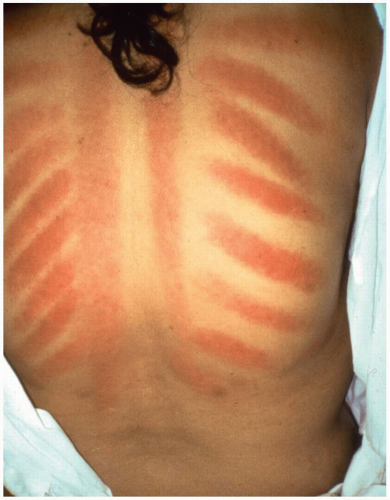Alternative Medicine
28-1 Coining/Spooning
Michael Greenberg
Clinical Presentation
Patients who have undergone coining or spooning present with multiple erythematous linear marks on the back and/or chest.1,2
Pathophysiology
“Coining” (cao gio in Vietnamese) is an ancient medical technique that originated in the Far East. The practice survives today and may be seen in members of various Asian communities. Coining is used to treat ailments including asthma, viral illnesses, cough, nausea, and vomiting. This practice is seen most frequently among members of the Vietnamese, Chinese, and Laotian immigrant communities.
One popular method of coining involves massaging the skin first with a mentholated oil or ointment, then forcefully stroking the skin with the edge of a coin, a spoon, or a comb. This produces the eccymotic/petechial streaking that is pathognomonic of this technique.
Diagnosis
The diagnosis is based on identification of the typical skin markings. It is important to obtain an adequate history, because the marks associated with these techniques may be mistakenly identified as indicative of child, elder, or spousal abuse.
Clinical Complications
Complications are rare but may include infection and scarring.
Management
In most cases, no treatment is indicated, and evidence of coining is simply an incidental finding.
REFERENCES
1. Crutchfield CE 3rd, Bisig TJ. Images in clinical medicine: coining. N Engl J Med 1995;332:1552.
2. Amshel CE, Caruso DM. Vietnamese “coining”: a burn case report and literature review. J Burn Care Rehabil 2000;21:112-114.
28-2 Cupping
Michael Greenberg
Clinical Presentation
Stay updated, free articles. Join our Telegram channel

Full access? Get Clinical Tree









